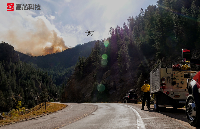By Evan Ackerman7 GMTLockheed‘s Drones Cooperate to Autonomously Put Out Fires
Photo: Lockheed Martin
Last year, Lockheed Martin demonstrated (semi) autonomous firefighting capabilities with an unmanned K-MAX cargo helicopter and a small quadrotor. There were still humans in the loop, though, and the whole test was carefully monitored to make sure that there were no conflicts with other aircraft in the area. Last month, Lockheed held another firefighting demo, this time with even more autonomy and real-time integration with air traffic control.
Usually, when big drones are doing big drone stuff, the Federal Aviation Administration sets up a Temporary Flight Restriction (TFR) around them, and air traffic control makes sure that no other aircraft get close. This is a good way of maintaining safety, but it’s super annoying for pilots, because it can turn straight line routes into slaloms. To be successful, unmanned aircraft systems (UAS) are going to have to learn how to play nice with other aircraft, and that means talking to air traffic control just like human pilots do.
Photo: Lockheed MartinLockheed Martin’s K-MAX unmanned helicopter and Stalker XE fixed-wing drone.
During Lockheed’s firefighting demo, both the K-MAX unmanned helicopter and Stalker XE fixed-wing drone used experimental UAS traffic management capabilities to maintain real-time communications with the local air traffic control system. This likely includes information like “here I am” and “here’s where I’d like to go,” along with an interactive component that allows the drones to respond to basic instructions from controllers.
For the actual firefighting part of the demo, the Stalker XE drone used its infrared camera to identify the fire, and then relayed its location to the autonomous K-MAX helicopter, which nailed the fire with a well-targeted water drop:
Fire spotting (and remote firefighting in general) is an excellent task for drones. It’s important to catch fires as soon as possible, since smaller fires are easier to manage, but the best we can do right now is to send out humans in light aircraft to wander around looking for smoke. Midsize fixed-wing drones could easily take over this task, covering enormous areas far more than humans can, equipped with dedicated fire spotting sensors to make them more effective as well. And since the drones would be operating only in remote areas, it wouldn’t be too much of a burden to our air traffic control infrastructure.
The Stalker XE can fly for 8 hours at a time, day and night and in all weather, and the K-MAX is also capable of anytime, all-weather operation, meaning that it could probably conduct water drops in the middle of a monsoon, if you wanted it to for some reason. But seriously, having robots like these available could mean that human firefighters on the ground get triple the amount of aerial support that they do now, relying on manned aircraft, which leads to fewer fires as well as increased safety for the people fighting them.
[ Lockheed Martin ]
自動翻譯僅供參考
洛克希德?馬丁公司的無人機能夠密切配合,自主撲滅火災(zāi) lockheed的無人機合作,自主提出fires
照片:洛克希德馬丁
去年,洛克希德馬丁公司展示(半)自治消防能力無人K-MAX貨運直升機和小型旋翼。不過,在循環(huán)中仍然有人,而且整個測試被小心地監(jiān)控,以確保在該區(qū)域沒有與其他飛機發(fā)生沖突。上個月,公司又舉行了消防演示,這一次甚至更多的自主權(quán)和實時空中交通控制一體化。
通常,當大型無人機正在做大型無人駕駛飛機時,聯(lián)邦航空管理局在他們周圍設(shè)置臨時飛行限制(TFR),空中交通管制確保沒有其他飛機接近。這是一種維護安全的好方法,但它對飛行員來說非常煩人,因為它可以將直線航線變成回旋。要想成功,無人駕駛飛機系統(tǒng)(UAs)必須學(xué)會如何與其他飛機打好關(guān)系,這就意味著和人類飛行員一樣進行空中交通管制。
photo:洛克希德馬丁martinlockheed 的K-MAX無人直升機和固定翼無人機跟蹤Xe。
在洛克希德 的消防演示的K-MAX無人直升機和固定翼無人機跟蹤氙實驗系統(tǒng)交通管理能力與當?shù)氐目罩薪煌?a target="_blank">控制系統(tǒng)保持實時通信。這可能包括像“信息;我在這里 和 這里 是我;我是想去, 隨著交互式組件,允許無人機應(yīng)對來自控制器基本指令。
的演示實際的消防部分,斯托克Xe的無人機使用紅外攝像頭識別火災(zāi),然后傳遞它的位置到自治K-MAX直升機,這把火一個針對性很強的水滴:《 / P 》 《 P 》 《 / P 》
飛火(和一般的遠程消防)是一個優(yōu)秀的任務(wù)的無人機。它’;的抓火災(zāi)盡快重要,因為較小的火災(zāi)很容易管理,但我們現(xiàn)在能做的最好的是送了輕型飛機的人四處尋找煙。中型固定翼無人機可以很容易地接管這一任務(wù),覆蓋大片地區(qū)遠遠超過人類,配備專用消防檢測傳感器,使他們更有效的為好。由于無人機將只在偏遠地區(qū)工作,就 不可太多我們的空中交通管制設(shè)施的負擔(dān)。
斯托克Xe能飛8個小時的時間,白天和黑夜,在所有天氣,和MAX也能隨時隨地,全天候運行,這意味著它可能會進行在季風(fēng)中的水滴,如果你想要它因為某些原因。但是說真的,有這樣的機器人有可能意味著人類消防員在地面上得到三空中支持的數(shù)量,現(xiàn)在他們做到了,依靠載人飛機,從而為人民而戰(zhàn)他們安全增加更少的火災(zāi)。
-
無人機
+關(guān)注
關(guān)注
230文章
10515瀏覽量
182430
發(fā)布評論請先 登錄
相關(guān)推薦
無人機自動巡檢系統(tǒng)功能與應(yīng)用
無人機巡檢系統(tǒng)光伏巡檢方案與作用
無人機通過什么傳輸信號
無人機信號傳輸技術(shù)的原理及分類
無人機干擾器對網(wǎng)絡(luò)的影響
無人機紅外熱成像技術(shù)在森林火災(zāi)監(jiān)測中的應(yīng)用

TATTU成為2024中國無人機競速聯(lián)賽技術(shù)服務(wù)商





 洛克希德?馬丁公司的無人機能夠密切配合,自主撲滅火災(zāi)
洛克希德?馬丁公司的無人機能夠密切配合,自主撲滅火災(zāi)










評論